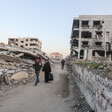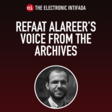Activism and BDS Beat 19 May 2011
More video footage has emerged showing scenes of Israeli violence against Palestinian refugees crossing from Syria into the Israeli-occupied Golan Heights on Sunday, 15 May. On Nakba day, Israeli soldiers fired tear gas and live ammunition at a mass march of Palestinian refugees who managed to walk across the militarized area. Ali Abunimah recently posted a video showing Israeli forces approaching and firing on the group as approximately a thousand Palestinian refugees crossed into the Golan — a dramatic assertion of their legitimate right to return to the land from which they were purged beginning in 1947-48.
One man, Hassan Hijazi, born in Syria but whose family is originally from Jaffa (south of Tel Aviv), was able to travel all the way to his town of origin to visit his grandfather and father’s house. He was arrested by Israeli police and held in detention — but not before making his nonviolent right of return action public. The Israeli press and mainstream US media has absurdly labeled Hijazi an “infiltrator,” as well as the other Palestinians who managed to cross into their homeland.
Today, two new videos were posted to YouTube by Baladee.net that show up-close footage of the marchers amassing in Majdal Shams and making their way to the fence, encountering throngs of armed Israeli soldiers, and the attacks that the soldiers launched against the unarmed demonstrators.
In the first video, Palestinian refugees prepare for the march. One man says that he is carrying a flower and a Palestinian flag, and states that Palestinians are coming to reclaim their land on the other side. The 4-minute video ends with the thousands of people standing at the fence, with dozens of Israeli troops stationed behind the fence.
The second video shows scenes of Israeli soldiers firing tear gas and rubber-coated steel bullets indiscriminately into the crowd of marchers, as people fight back by throwing stones.
Meanwhile, the Israeli army released a statement today saying that the “events” that occurred on Nakba day are leading the military to “acquire more [weapons for] riot dispersal” in the near future.






Comments
videos
Permalink Anaheed replied on
The first video is filmed from the perspective of the Israeli occupied Jolan. It mixes chronological sequences. The first video starts with the people of Majdal Shams telling Palestinian demonstrators who managed to enter the town that they were afraid for them. The man with the flower and the flag isn't preparing for the march, he is a Palestinian who already crossed over into Majdal Shams, and is asked by the interviewer what he would like to say from occupied Jolan, to which he says I would have liked to continue onto Palestine, one day we will. Then we are taken back in time to what seems to be the towns preparation for the demonstration from the Israeli occupied side, and the peoples of Majdal's own march towards the border, before we see them amassing in front of the fence which seems to demarcate the strip of land that is the border area, and in which there are Israeli soldiers (so we are still looking out from the Israeli occupied side).
The second video also seems to be from the Israeli occupied side of Syria, the tear gas and coated steel bullets seems to be directed at the people of Majdal Shams. The Israeli soldiers have their back towards them and are more concerned with the other side. Towards the end of that sequence, the camera moves to the Palestinians in the distance on the other side of that strip of land in which the Israeli soldiers are based, and we hear live fire. We are then taken to the injured, and to the rally Majdal Shams. Here the chronology is once again not in sequence, and it is difficult to tell whether this was after the Palestinians came or before the people of Majdal Sham went to the border. At the very end the man on the speaker phone at the rally is clearly welcoming the Palestinians in the face of the fake British-French imposed colonial borders that carved up the area, it is unclear whether he is referring to those who crossed over from Syria or Palestinians from '48 Palestine (probably the latter).